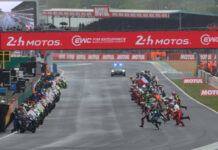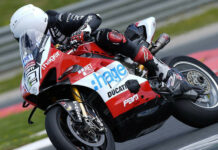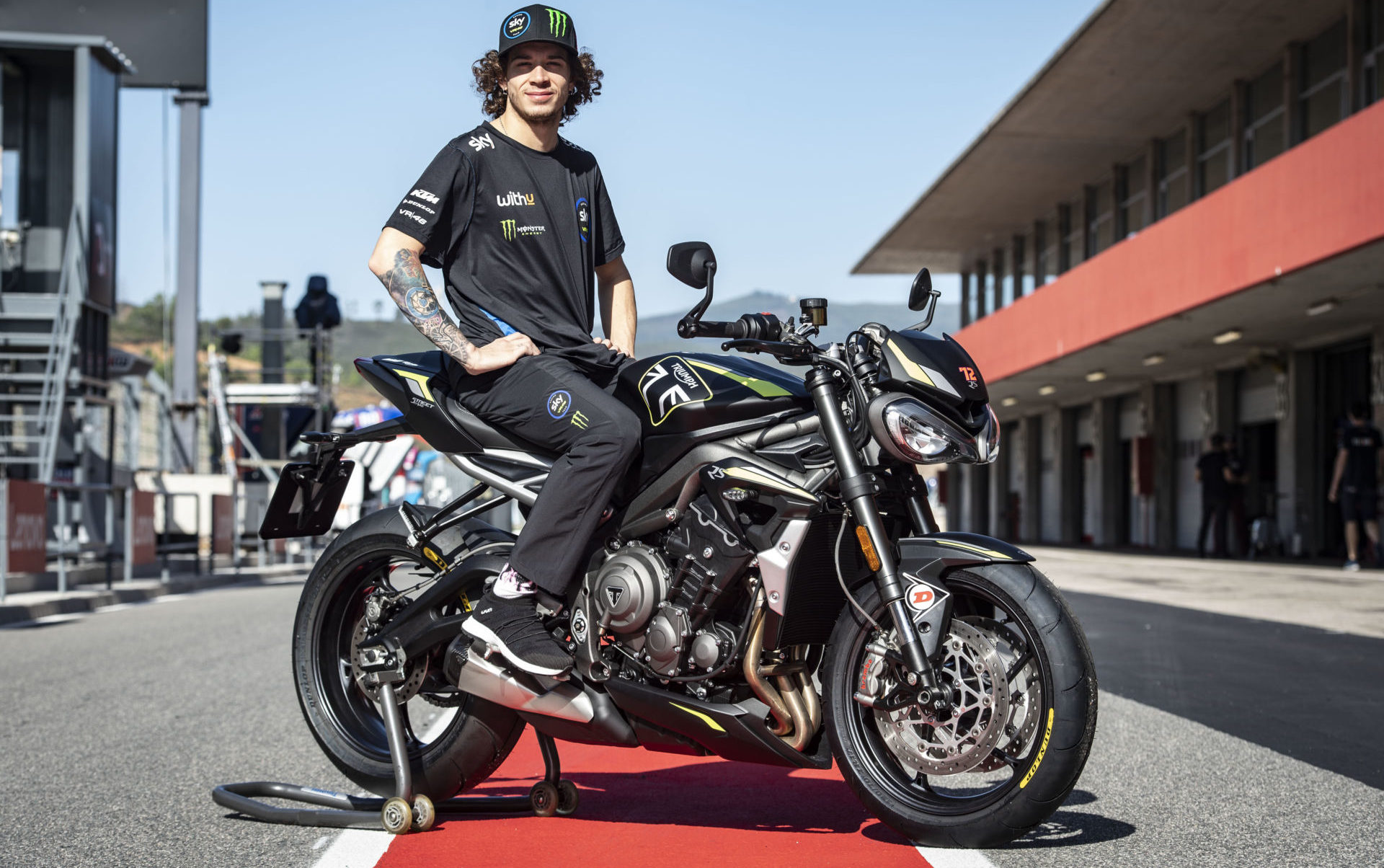By Michael Gougis
It started as a conference call to celebrate a young racer winning a contest and getting a free motorcycle.
But it evolved into a nearly hour-long discussion Thursday morning with Moto2 racer Marco Bezzecchi, motojournalists worldwide and representatives of Triumph about the future direction of motorcycle road racing and how the company’s 765cc three-cylinder engine is helping shape that direction for GP and Supersport racing today.
As a way to increase the visibility and profile of Triumph’s involvement in Grand Prix racing (the company provides the spec powerplants for the Moto2 category), the company conducted a Triumph Triple Trophy contest for Moto2 competitors. Points were awarded for fastest top speed, pole position and fastest race lap over the course of a race weekend.
Bezzecchi, 22, scored the most points in those categories and was awarded a Triumph Triple Trophy-Livery Street Triple RS for his efforts. The unique color scheme met with Bezzecchi’s approval: “Aggressive,” he called it.
But when Bezzecchi turned his thoughts to the Triumph-powered Kalex that he has raced for SKY Racing Team VR46 to wins, podiums, fast lap and pole position this year in Moto2, he provided insight into why the change from the Honda CBR600RR-based powerplant to the 765cc Triumph was so significant for potential MotoGP contenders.
The additional torque, power (more than 140 bhp) and much, much more sophisticated electronics that came with the switch to the Triumph engine in 2019 made the Moto2 machines much closer in performance to a modern MotoGP bike than the Honda-engined motorcycles were, Bezzecchi said.
In fact, Bezzecchi said his current Moto2 machine was comparable to the Yamaha YZF-R1s that he trains on with the VR46 Academy. While the Yamaha has more top-end power, the Triumph, he said, matches and exceeds the R1’s torque at lower rpm.
“Now the gap between Moto3 and Moto2 is bigger than the gap between Moto2 and MotoGP,” Bezzecchi said.
Not only is the Triumph 765 engine making an impact in Grand Prix racing, the bike from which that engine is derived is slated to be tested in British Supersport for its potential to participate in the World Supersport arena. The middleweight category continues its slide in popularity, a major concern for the sanctioning bodies with Supersport classes that are made up predominantly of 600cc Inline-fours.
An indication of that slide is the announcement this week by Yamaha that its iconic YZF-R6 will no longer be produced as a streetbike and will no longer be homologated for Supersport racing. (Bikes homologated for World Supersport use are eligible for competition for eight years after receiving approval.)
In response, BSB and Dorna officials have reached a deal to allow Triumph to enter a racing version of its Street Triple RS into the British Supersport class to study how well that vehicle (and the Ducati Panigale V2) fit into the category. The move is a precursor to the introduction of those models into World Supersport competition.
The Triumph 765 is well-suited to competition, said Steve Sargent, Triumph Motorcycle’s Chief Product Officer. The Moto2 version of the engine features modifications to the head, fuel injectors and cams to free up the breathing. It eliminates the starter motor and gearing, runs a racing alternator and an F.C.C. clutch to reduce the mass of moving parts inside the engine, and as such spins to 14,000 rpm safely and reliably.
“When we started, I watched every session for the first five or six races through my fingers,” Sargent said. “After that, I stopped worrying.”
The company’s only real concern was with racers who were over-revving the engine on downshifts, sometimes to more than 15,000 rpm, he said. “We had to talk to some of them,” Sargent said. “Some of them, we had to talk to several times.”
Bezzecchi said he’s not really interested in upping the performance of his new trophy, although he did say he planned to put a louder exhaust on it. But that will happen only after he gets to ride it – which he cannot do right now. The winner of multiple Grand Prix races in Moto3 and Moto2, he not only does not own a streetbike, but takes the bus around his home town because he does not have a motorcycle license!







